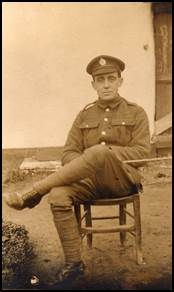
205258
(W/R 503651) Acting Sergeant
WILLIAM WILSON BANNATYNE
Royal
Engineers
By
Lieutenant Colonel Edward De
Santis, MSCE, P.E., MinstRE
(March 2023)

Figure 1. W/R 503651 Sapper
William Wilson Bannatyne, R.E.
(Image from the author’s
collection)
1. INTRODUCTION
This research was prompted by the author’s acquisition of a postcard photograph of William Wilson Bannatyne taken near the end of the Great War of 1914-1918. The photograph is shown in Figure 1 and on the back of the postcard, presumably in Bannatyne’s handwriting, is his signature with the date 14 February 1918.

Figure 2. The Signature of William Wilson Bannatyne.
Bannatyne’s military service papers were located on the Ancestry.com web site. Unfortunately the copies of his papers were from the burnt record files at The National Archives, so much of the information contained in the papers is illegible. No family tree could be located for him on Ancestry.com, so little is known of his early life or his life after leaving the army following the war. The information contained in this narrative is as complete as the author could make it, given the documents available. Where no citation is given for facts presented, the reader should assume that the information is from Bannatyne’s service papers.
2. FAMILY INFORMATION AND EARLY LIFE
Family Information
William Wilson Bannatyne was born in August 1888 in the Cape Colony of South Africa. In his Attestation Paper Bannatyne lists his mother, Christina Bannatyne, as his next of kin. Her address is shown as Buffalo Nek, Mount Frere, Cape Colony, South Africa. Mount Frere is a small town located about 126 miles west northwest of Port Edward on the coast of East Africa. No mention is made of William’s father in his service papers, but the 1901 Census of Scotland indicates that he had an uncle living in Govan, Lanarkshire at that time.
Early Life
At the age of 12 William was residing in his uncle’s home in Scotland as shown in the census table below. William is shown as a Scholar in the census and his birth place is shown as Cape Colony.
1901 Census of Scotland
Residence: 3 Clarence Drive, Govan, Lanarkshire.[1] |
|||
Name and Surname of each Person |
Relation |
Marital Status |
Age |
James Bannatyne |
Head |
Married |
34 |
Jeanie Bannatyne |
Wife |
Married |
34 |
Douglas W. Bannatyne |
Son |
|
4 |
Jan M. Bannatyne |
Son |
|
3 |
William W. Bannatyne |
Nephew |
|
12 |
Mary Cumming |
Servant |
|
20 |
Sarah McNiven |
Visitor |
|
31 |
James Bannatyne must have been the brother of William’s father who
had agreed to have William live with him while he attended school in
Scotland. William went on to study Civil Engineering and
Surveying while at school in Scotland and upon graduation he took a
position with an engineering firm in Glasgow. While he was
working in Glasgow his address was 71 Abbotsford Place.[2]
William returned to South Africa sometime between 1912 and 1915, probably to visit and/or live with his mother and family there. According to his service papers, when he returned to the U.K. he landed at Plymouth, Devonshire aboard the S.S. Kildonan Castle on 4 July 1915, however, the ship’s manifest shows that the Kildonan Castle arrived in London from Natal on 7 July 1915 with W.W. Bannatyne a 26-year old Land Surveyor on board. He took up residence at his old lodgings at 71 Abbotsford Place in Glasgow before enlisting in the Royal Engineers in December 1915.
|
Figure 3. The Union-Castle
Line S.S. Kildonan Castle.
|
3.
PHYSICAL DESCRIPTION
The following is a description of William Wilson Bannatyne just prior to his enlistment in the Royal Engineers in December 1915. The description is based on his medical examination for enlistment which was made in Glasgow on 11 September 1915.
Declared age: |
27 years and 1 month |
Height: |
5 feet 9½ inches |
Weight: |
124 pounds |
Girth fully expanded: |
34½ inches |
Range of expansion: |
3 inches |
Physical development: |
Very good |
Vision: |
Right eye: 6/12. Left eye: 6/18(1) |
Distinctive marks: |
Birth mark on right hip and thigh. Mole on right scapula. |
Religion: |
Presbyterian(2) |
TABLE NOTES:
(1) Vision results are based on the Snellen Visual Acuity Test. A vision of 6/6 is considered to be normal and not requiring correction. Bannatyne’s vision was obviously in need of slight correction.
(2) For some strange reason, in the British Army the man’s religion was always noted as part of his physical description resulting from his medical examination on enlistment.
(3) There was no indication in his medical examination record to indicate that he had ever been vaccinated against smallpox. Normally the examining medical officer would indicate in the recruit’s record any indication of previous vaccination marks on his arm(s).
4. RECRUITMENT, ENLISTMENT AND TRAINING
Recruitment
Bannatyne’s return from Natal to the U.K. in the summer of 1915 probably was due to his desire to enlist in the forces. It is not known whether he was recruited to join while in South Africa or whether he just decided to served for King and country.
Enlistment
Based on the results of his medical examination he was determined to be fit for service. On 5 December 1915 he enlisted in the Royal Engineers at Glasgow. His civil occupation as a Civil Engineer and Surveyor made him an attractive recruit for the Corps. Because of his educational level he was certainly considered to be an asset of great value.
As with all recruits he was required to answer a number of questions as part of his Attestation. He declared his trade to be Civil Engineer[3] and that he was not married. He stated that he had four years of prior service with the 9th Battalion of the Highland Light Infantry, that he was willing to be vaccinated and to enlist for General Service for the duration of the war.
The 9th (Glasgow) Battalion of the Highland Light Infantry was a unit of the Territorial Force with its headquarters at 81 Greendyke Street in Glasgow. It was made up of eight companies and was part of the HLI Brigade of the Lowland Division when war broke out in August 1914. The battalion was at once mobilized and moved to Dunfermline in a defensive role. On 5 November 1914 the battalion proceeded to France. From what is known about Bannatyne during this period, he obviously was not with the battalion when it was mobilized for war. The four years that he served in the unit had to have been between August 1906 (his 18th birthday) and August 1914 when the battalion was mobilized.
On his Attestation form he agreed to be enlisted for General Service, but in parentheses after the word “Yes” he had written (Royal Engineers), seeming to indicate that his service was to be in the Corps of Royal Engineers.
His Attestation was certified by a Magistrate on 5 December 1915 and on the following day he was posted to the Army Reserve, when presumably he went back to work as a Civil Engineer or as a Surveyor in Glasgow. He remained in the Army Reserve until 27 September 1916 when he was mobilized at Sandwich, Kent as a Sapper, Regimental Number 205258, with the military trade of Surveyor (Theodolite). His Regimental Number was one of the series of numbers that had been issued to men serving in the Inland Water Transport.
The Inland Water Transport Section of the Royal Engineers was originally formed in December of 1914 to deal with and to develop transport on canals and waterways of France and Belgium. The Section at first operated under the Director of Railways, but, owing to the rapid development of Inland Water Transport, a special directorate was formed in October of 1915.[4]
On 10 October 1916 his Attestation was approved by an officer of the Inland Water Transport at Sandwich and his Regimental Number was changed to W/R 503651. Sapper Bannatyne’s duties at Sandwich during his time there was probably associated with ferrying service to France.
During the Great War a secret "Q" port by the banks of the River Stour was the starting point of a ferry service for troops and munitions to France and Flanders. Camps were occupied by thousands of soldiers who were taken by day or by night across the North Sea and the Channel to Dunkirk and Calais. The chosen spot for the hidden port was under the Roman fortress of Richborough; and a railway was constructed from the main line which passed under the Saxon walls to the banks of the Stour. The river mouth was dredged; and a new port of embarkation was created. The camp was constructed in the marshlands on both sides of the river. Most of the work undertaken by the Royal Engineers and much of the equipment and arms for the Ypres Salient were sent across from Richborough Port, using sea going barges and the very first roll-on roll-off ferries. Obviously Inland Water Transport personnel would have been busily engaged with this work.[5]
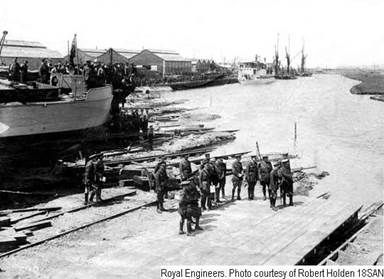
Figure 4. Richborough
Port.
(Image and note text: Royal Engineers – Courtesy of
Robert Holden)
NOTE: This photograph shows Richborough Port looking towards the sea and gives some idea of the size of the installation. Of particular interest is the barge being built on the slipway on the left of the picture. Richborough Port had workshops and a smithy to facilitate the construction of vessels.
Training
There was no information posted in Bannatyne’s service papers to describe his military training. As a member of a Territorial Force infantry battalion for four years he had certainly been trained in the basics of soldiering. As a Civil Engineer and Surveyor he did not require any training in these fields. He entered the Army with the trade of Surveyor, so he probably was immediately put to work in this field.
5. POSTINGS, ASSIGNMENTS AND CAMPAIGN SERVICE
Home Service (1916-1917)
Bannatyne appears to have remained at Sandwich from 15 October 1916 to 3 January 1917 working at the port facility there. During this period he was appointed to the rank of 2nd Corporal, although his records do not indicate the date of this appointment.
France and Flanders (1917-1919)
2nd Corporal Bannatyne embarked for France on 4 January
1917. Once he arrived in France he was posted to the Inland
Water Transport in which he served until 7 March when he joined the
Office of the Director General of Transportation (D.G.T.). This
office set to work to coordinate all forms of transportation –
docks, railways, light railways, inland waterways and roads.
The D.G.T. appointed a Chief Engineer Port Construction (C.E.P.C.),
Sir Alexander Gibb (a well-known contracting engineer), who reported
directly to the D.G.T.
|
Figure 5. Sir Alexander Gibb, Chief Engineer Port Construction (Image courtesy of the National Portrait Gallery)
|
The appointment of the C.E.P.C. was necessary for
reconstruction of ports in France and in Belgium as the British
Armies advanced. The first work of this department was the
construction of ports at Dunkirk, Calais, Dieppe and Cherbourg for
the Channel ferry which started from Richborough. These
proposed ports required the preparation of plans and the layout of
the port facilities using Surveyors to implement the plans. On
21 March 1917 Bannatyne joined the Office of the Chief Engineer Port
Construction as a Surveyor and was engaged in this work and remained
with it until the end of the war.
|
Figure 6. A Surveyor of the Royal Engineers. (Image courtesy of The National Archives)
|
The C.E.P.C. had a number of Port Construction Companies under his command. These included the following:
No. 1 Company at Lery
No. 2 Company at Quévilly-Rouen
No. 3 Company at Oissel-Rouen
No. 4 Company at Rang-de-Fliers
No. 5 Company at Les Forts-Bergues
No. 6 Company at Dunkirk
No. 7 Company at Ostend
No. 8 Company at Boulogne
No. 11 Company at Havre
These companies provided the manpower and the equipment necessary to construct the planned port facilities. Bannatyne may have worked with some, if not all, of these companies during his time in France and Belgium.
On 1 September 1917 Bannatyne was granted 10 days leave in the U.K. and he probably went to Glasgow to visit his family. He returned to France after his leave and rejoined the R.E.P.C. headquarters. On 27 September he was granted War Pay at the rate of 1 pence per day in addition to his regular military pay.
On 15 February 1918 Bannatyne was promoted to the rank of Corporal and was posted to No. 2 Port Construction Company at Quévilly-Rouen. On 15 September he was granted 14 days leave to the U.K. and on 27 September he was granted War Pay of 2 pence per day. It should be noted that on the day before his promotion and transfer to Quévilly-Rouen he had his photograph taken for the postcard that initiated this study of his military service.
When the war ended Bannatyne remained in France for quite some time. Anticipating his return home to South Africa, on 7 January 1919 he made application for repatriation to the Cape Colony. Since he had come from South Africa to join the British Army he felt that he was entitled to a government-paid trip back to his home. His application for passage home requested transportation to Kokstad, East Griqualand, Cape Colony, South Africa. He also applied for reimbursement for his passage to the U.K. from South Africa in 1915. With his application for reimbursement for the 1915 voyage he submitted two references related to his pre-service work in Glasgow. These references were: John Cowan, M.I.C.E., St. Vincent Street, Glasgow and Adam Hunter, M.I.C.E., c/o Sir William Arrol & Co. Ltd., Bridgeton, Glasgow. Sir William Arrol & Co. was a prestigious Scottish civil engineering and construction business. It built some of the most famous bridges in the United Kingdom including the second Tay Bridge, the Forth Bridge and Tower Bridge in London. Bannatyne’s application was approved on 15 January.
On 1 February 1919 Bannatyne was posted from No. 2 Port Construction Company back to the headquarters of the Chief Engineer Port Construction. On this date he was also appointed an Acting Sergeant (paid). He departed France for the U.K. on 4 March and appears to have been given some post-war leave until 11 May 1919 when he reported to No. 1 Dispersal Unit in Kinross, Scotland in preparation for his discharge. His Medical Category at that time was noted to be B1. This category indicated that he was free from serious organic diseases, able to stand service on lines of communication in France, or in garrisons in the tropics. It also indicated that he was able to march five miles, see to shoot with glasses and hear well. It appears that his less than normal vision found when he enlisted was finally recognized by the Army.
On 13 May 1919 Bannatyne again made application for passage home to South Africa. He requested that he be booked to the port nearest to his home, Franklin, via Durbin. At the time that he made this application he was living at 76 Earlspark Avenue in Newlands, Glasgow.
Discharge
(1919)
Acting Sergeant William Wilson Bannatyne was transferred to the Class “Z” Army Reserve on demobilization at London. His place of rejoining the forces in case of emergency was Sandwich, Kent and his Medical Category was upgraded to A, essentially indicating no restrictions on service in the Army. He was still living at the Earlspark Avenue address when he was discharged.
The following sections are presented in tabular form to summarize Bannatyne’s promotions, appointments, military training and qualifications and the medals that he was awarded during his time in the Army. They are provided to give the reader easy access to these aspects of his military career. The tables are followed by sections dealing with his marriage, personal information and post-service life.
6. PROMOTIONS AND APPOINTMENTS
Promotions: Bannatyne received the following promotions during his time in service:
Date of Promotion or Appointment |
|
5 Dec 1915 |
Appointed Sapper upon enlistment. |
About Dec 1916 |
Appointed 2nd Corporal. |
15 Feb 1918 |
Promoted Corporal. |
1 Feb 1919 |
Appointed Acting Sergeant (paid). |
Appointments: Bannatyne received the following appointments during his time in service:
Date of Appointment |
|
27 Sep 1916 |
Appointed Surveyor (Theodolite), I.W.T. |
7 Mar 1917 |
From I.W.T. to D.G.T. |
21 Mar 1917 |
From D.G.T. to C.E.P.C. |
15 Feb 1918 |
From C.E.P.C. to No. 2 Port Construction Company. |
1 Feb 1919 |
From No. 2 Port Construction Company to C.E.P.C. |
TABLE NOTES:
(1) I.W.T. Inland Water Transport.
(2) D.G.T. Office of the Director General of Transportation.
(3) C.E.P.C. Chief Engineer Port Construction.
7. MILITARY TRAINING AND QUALIFICATIONS
Military Training
As previously noted, Bannatyne received his military training while he served with the 9th Battalion of the Highland Light Infantry. As a school-trained Surveyor when he enlisted, he needed no further military training in this trade.
Qualifications
Bannatyne was a proficient Surveyor when he enlisted in the Corps of Royal Engineers.
8. MEDALS, AWARDS AND DECORATIONS
For his service during the war Acting Sergeant Bannatyne was awarded the British War Medal and Victory Medal as shown on his Medal Index Card below.
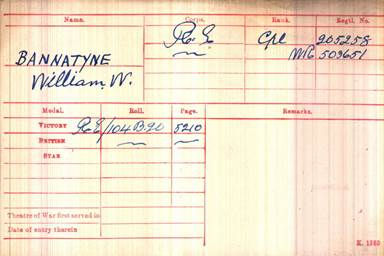
Figure 7. The Medal Index Card
of William Wilson Bannatyne.
(Image courtesy of
Ancestry.com)
The Medal Index Card shows him as a Corporal, however his Protection Certificate and Certificate of Identity (Army Form Z. 11) issued to him upon his discharge shows his rank as Sergeant.
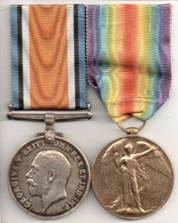
Figure 8. The British War
Medal and Victory Medal.[6]
(Image
from the author’s collection)
In addition to his Medal Index Card, the Royal Engineers Medal Roll for these two medals (see image below) show his rank as Acting Sergeant.
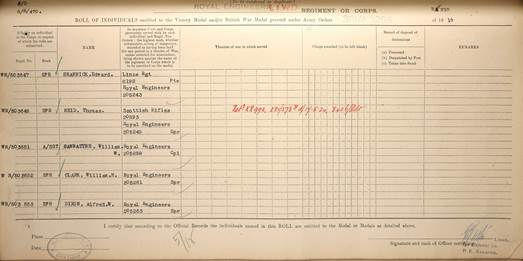
Figure 9. The Royal Engineers
Medal Roll for the British War Medal and Victory Medal.
(Image
courtesy of Ancestry.com)
Bannatyne received these medals on 22 October 1922 while he was in South Africa in the employ of the Irrigation Department.
9. RELEASE FROM SERVICE
Acting Sergeant Bannatyne was released from service on 7 June 1919 with his transfer to the Class “Z” Army Reserve. His total service was reckoned as shown in the tables below:
Location |
|
Glasgow, Scotland (Enlistment) |
13 September - 5 December 1915 |
Glasgow, Scotland (Army Reserve) |
6 December 1915 – 26 September 1916 |
Sandwich, Kent |
27 September 1916 – 3 January 1917 |
France and Flanders |
4 January 1917 – 4 March 1919 |
Kinross, Scotland |
5 March 1919 – 13 May 1919 |
London |
14 May 1919 – 7 June 1919 |
Location |
|
Home Service (Active) |
278 days |
Service Abroad (Active) |
2 years, 2 months and 1 day |
Total Service (Active) |
2 years, 2 months and 279 days |
Service in the Army Reserve |
296 days |
Service in the Territorial Force |
4 years |
Total Service with the
Colours: 7 years, 2 months and 210 days, including all of the above.
Marriage
In the Electoral Register of 1920 William W. Bannatyne is listed as living at 75 Earlspark Avenue in Glasgow. Also living at that address is Jessie C. Bannatyne. It is not known whether this person could be William Wilson Bannatyne’s wife.
Parents
Other than the information regarding his mother, Christina Bannatyne, living in Buffalo Nek, Mount Frere, Cape Colony, South Africa, nothing more could be found regarding his parents.
Siblings
No information available.
11. POST SERVICE LIFE
Bannatyne’s service papers show that on 1 July 1919 he prepared to embark for South Africa and was to sail aboard S.S. Edinburgh Castle on 20 July.
All that is known about Bannatyne’s post service life is that he returned to South Africa after the war, presumably to Kokstad and that he took a position, probably as a Surveyor, with the South African Department of Irrigation.
|
|
REFERENCES
Books
The History of the Corps of Royal Engineers, Volume V, Home Front, France, Flanders, Italy in WW1. The Institution of Royal Engineers, Chatham, Kent, 1952.
The Work of the Royal Engineers in the European War, 1914-1918 (Miscellaneous), compiled by Colonel G.H. Addison, C.M.G., D.S.O., M.A., M.I.Mech.E. The Institution of Royal Engineers, Chatham, Kent, 1926.
Census
1901 Census of Scotland.
Civil Documents
Electoral Register, Glasgow, 1912.
Electoral Register, Glasgow, 1920.
Internet Web Sites
The War Memories Project: 9th (Glasgow) Battalion, Highland Light Infantry during the Great War.
https://www.wartimememoriesproject.com/greatwar/allied/battalion.php?pid=631
Richborough Port during the World Wars.
http://www.open-sandwich.co.uk/town_history/richborough_port.htm
WW1 in Kent.
https://kentww1.com/richborough-port-showing-the-dock-area-with-barge-construction/
Military Documents
Medal Index Card.
Royal Engineers Medal Roll: British War Medal and Victory Medal.
Military Service Papers (Burnt Record Files)
a. Short Service Attestation.
b. Descriptive Report on Enlistment.
c. Military History Sheet.
d. Statement of Service.
e. Protection Certificate and Certificate of Identity.
f. Statement as to Disability (Army Form Z. 22).
g. Medical History.
h. Application for Deferred Passage (Army Form Z. 45).
i. Particulars of Claim for Repatriation to an Overseas Possession.
j. Casualty Form – Active Service.
k. Letter from W.W. Bannatyne to OIC, No.6 Section, Transportation Branch, Winchester, dated 8 July 1919, re: Passage to South Africa.
l. Memorandum from R.E. Record Office, Chatham to W.W. Bannatyne, dated 8 September 1922, re: Award of the British War Medal.
Ship’s Manifest
S.S.
Kildonan Castle,
from Natal to London, arrival date 7 July 1915.
ENDNOTES
[1]
There is a modern building currently located at this address.
[2] This address no longer exists in Glasgow. Re: 1912 Electoral Register.
[3] It must be noted that there is no information verifying that he had a university degree in Civil Engineering. It is possible that he received technical training in this field, as well as the field of Surveying, and that he conferred these titles on himself. The Army probably did little to verify this information. Furthermore, if he had a Bachelor of Science Degree in Civil Engineering, it is almost certain that the Army would have found more prestigious position for him rather than Sapper (Surveyor). He might even have received a commission as an officer.
[4] ADDISON, G.H.
[5] Richborough Port during the Great War.
[6] These are not Bannatyne’s medals. The image is included here simply to show what the medals looked like. The whereabouts of his actual medals are not known.